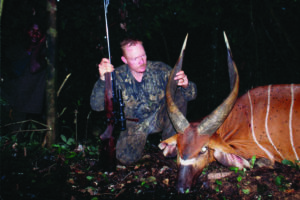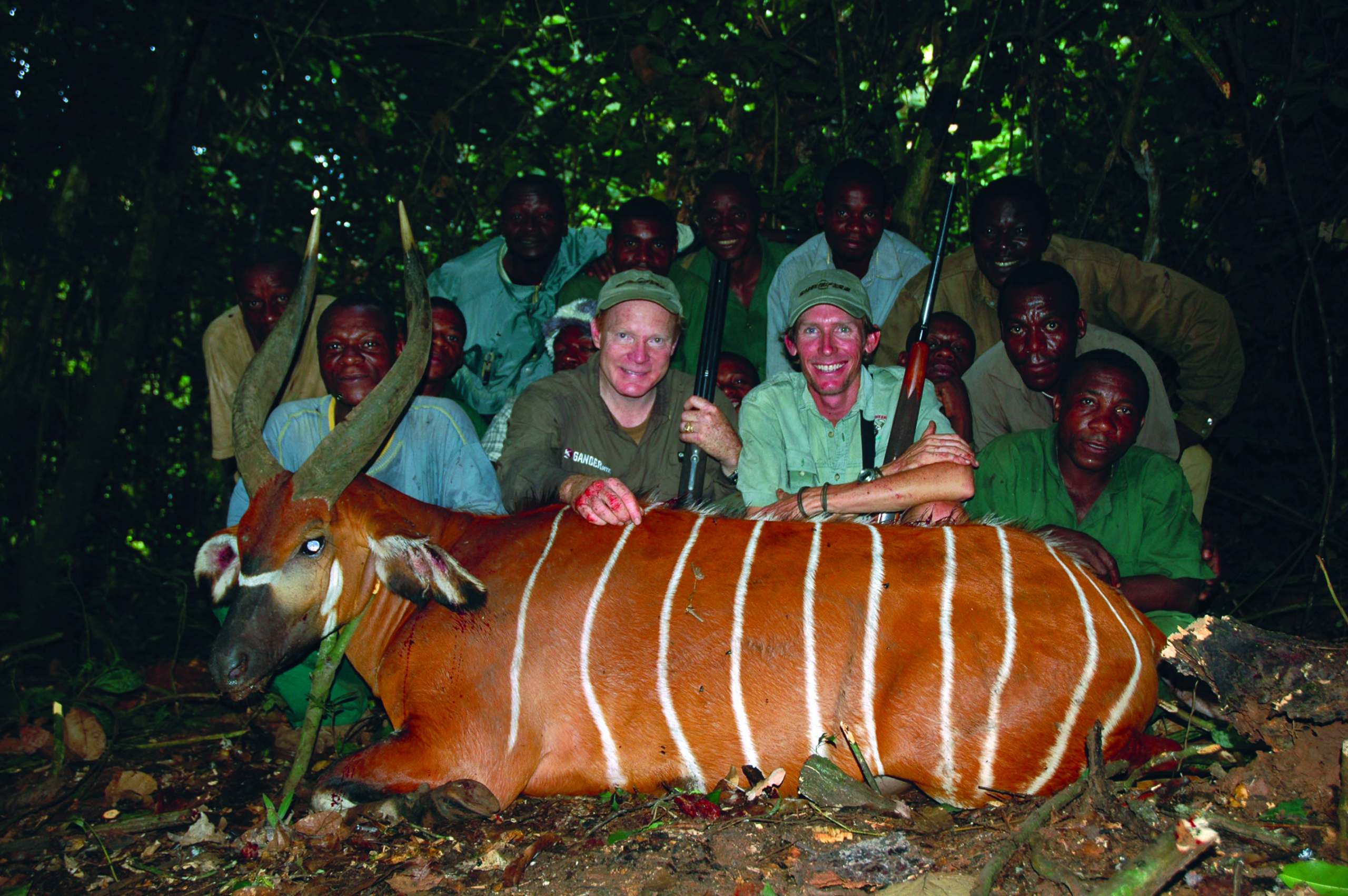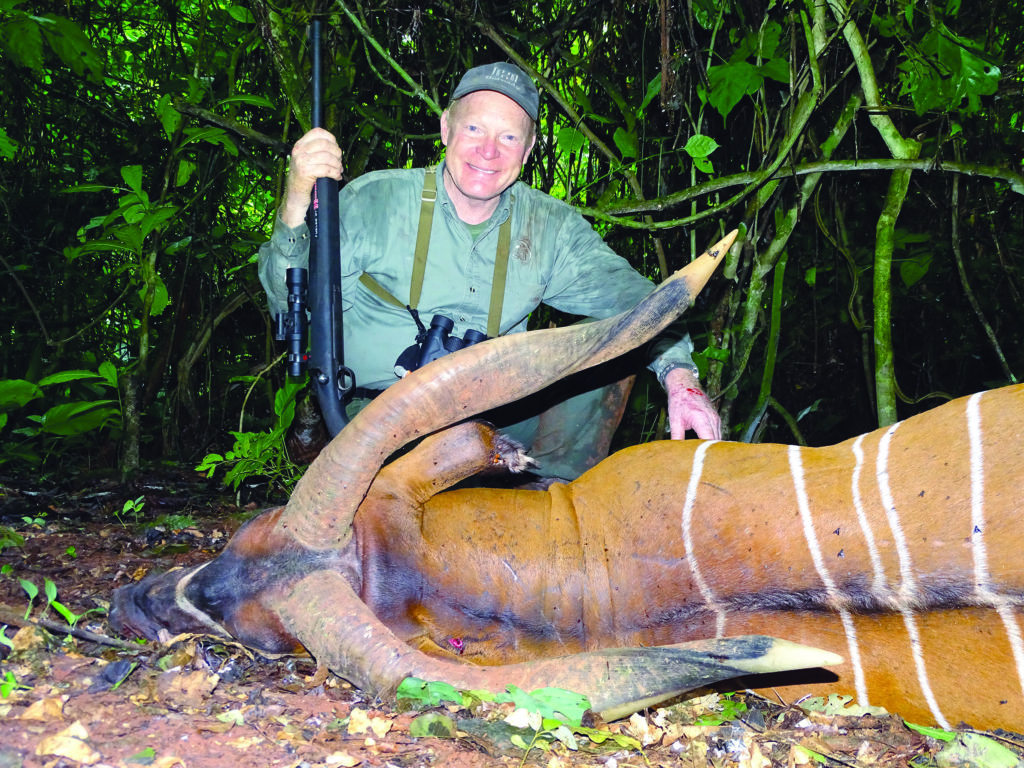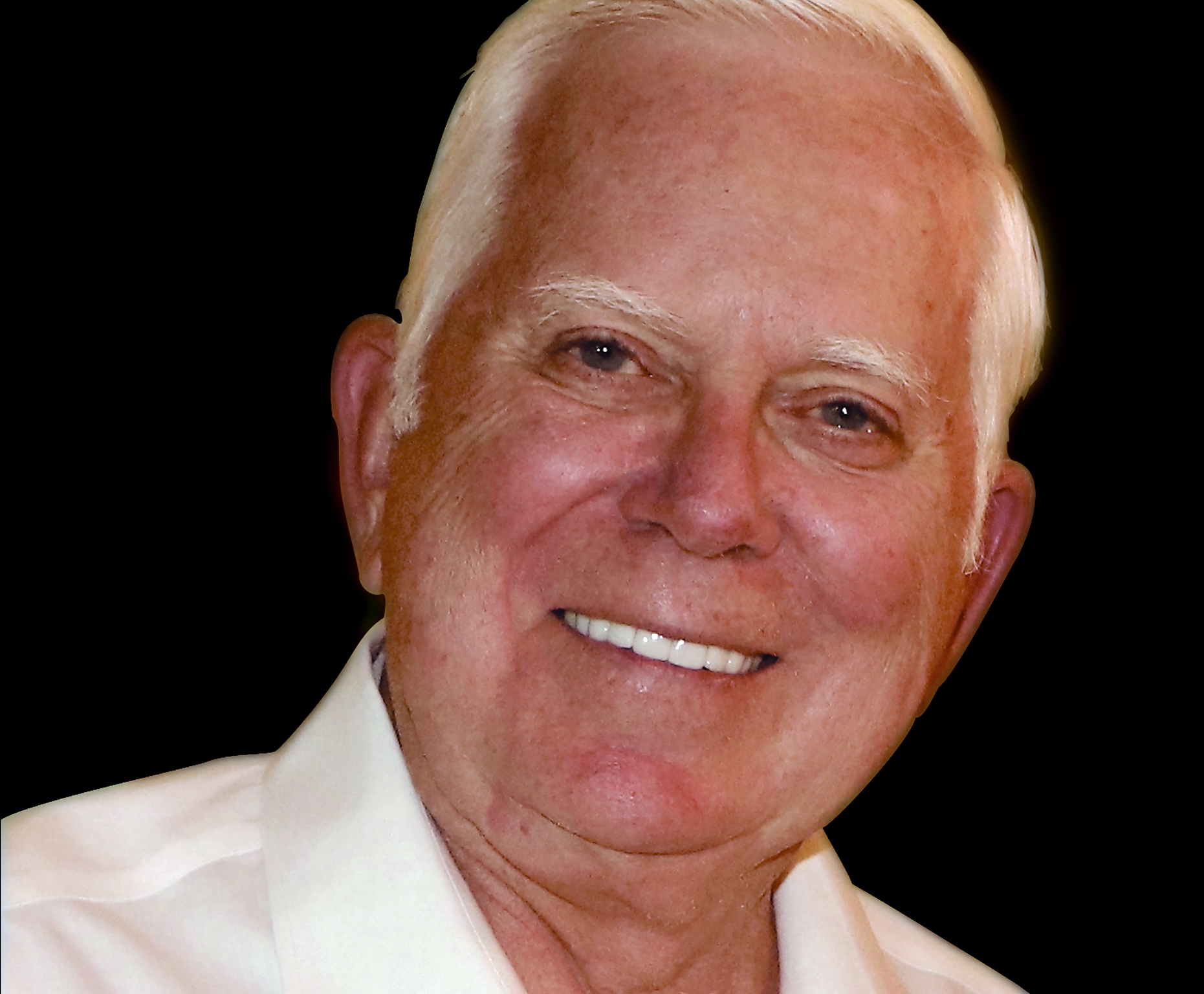Author Craig Boddington reckons that this massive bull taken in Congo (Brazzaville) in 2018 is his best-ever African animal. Body size is amazing, certainly exceeding 800 pounds.
It’s a myth that hunting for bongo is always hot, miserable and exhausting. Truth is, this large spiral-horn antelope is a challenge.
By Craig Boddington
The forest floor was dry. Leaves crackled with every step. The big track of a single bull led us through thick forest. Our Pygmies held the spoor, now and again losing it, casting ahead, then moving on. We followed for hours through dark forest. Visibility was 30 yards or less. Often, we moved on hands and knees. Naturally, the Pygmies saw him first, although what they saw I will never know. I saw nothing until the bull moved. The rifle was coming up when the bull went to the right, across our front. I had the impression of a big orange animal, no clue on horns. Then he was gone, long before the rifle got to my shoulder. That was the 20th day of my first bongo safari. It was the only bongo I glimpsed in three weeks of hard hunting. It seemed we followed that bull for miles, but probably not. You don’t cover much ground as you wind through thick forest. Nor, in my experience, does a bongo bull travel far. He is the true king of the African forest, supremely confident in his dense habitat.

GOOD LUCK AND BAD
That was my first safari in the African forest. I hunted with Jacques Lemaux. We hunted in southeast Central African Republic in May 1996, not far from the border of Zaire, now Democratic Republic of Congo. Over the previous 20 years I’d been on many safaris. I thought I knew African hunting. Maybe I did, but I didn’t know the forest. I’d never hunted vegetation of such uniform density. It’s daunting and days pass without seeing a living animal. We were hunting by pure tracking with great Pygmy hunters. Bongos were plentiful, along with other forest game, but it’s tough. At the outset, Jacques explained that a bongo safari usually unfolds in four phases. “First, we find tracks,” he said. “Then, we make contact. Then we see the bongo. Finally, we shoot him.” The first part was easy. I suppose we started fresh tracks seven or eight times. Phase 2 also wasn’t so bad. We made contact several times, hearing unseen bongos crash off in front of us. Once, we were so close that a branch was still swaying as the bongo casually walked away from us. But we only caught one glimpse of that orange hide. I would learn on subsequent safaris that this part of the forest isn’t as dense as it gets. Technically, this was finger forest, interspersed with occasional fingers of savanna.
As with all tracking, there’s luck as to where the animals are when you make contact. My hunting partner, the late Sherwood Scott, was guided by Rudy Lubin, also a great forest hunter. They tracked a bull into one of those narrow savannas and Scotty shot him when he jumped from his bed. I didn’t have that kind of luck and we also had poor luck with rain. In May, it should have been raining every second or third day. Rain is critical to forest hunting. All forest denizens seem most active after a rain and, after a hard rain, all tracks are fresh and the forest floor is quiet. We started this hunt with good rains. Scotty got his bongo and Jacques and I had tracks to follow. Then it didn’t rain for two weeks! Earlier in the season, bongos are often hunted from machans and, when the Pygmies employ dogs, quiet doesn’t matter so much, but for pure tracking, you need rain. A great truth I learned on that hunt: “No rain, no bongo!” With all the great prizes, you’re better off to concentrate all your efforts on that one animal, to a point. Encounters in the forest are random. I did not follow the credo of “bongo or nothing.” Afternoons, we often called duikers. One sweltering afternoon, sitting on a termite mound, I thought a herd of buffalo was stampeding. A lone yellowback duiker came in! Once, checking a distant salt lick for bongo tracks, we saw giant forest hogs wallowing. At hunt’s end, I wondered if I might have been more successful if I had stuck with the bongo program. Maybe, but the yellowback and a big giant forest hog were awesome consolation prizes. Today, I know the forest is too fickle for absolute specialization. A final truth from that first forest safari: “Take what the forest offers.”
MYTH AND REALITY
It is said that an early missionary who liked to hunt convinced local tribes that the bongo carried leprosy. The story may be true, but contagion is not. The bongo is of the spiral-horned tribe, Tragelaphus eurycerus. From Greek, the former means goat-deer, and the latter comes from the word for broad-horn. It was first described by naturalist William Ogilby in 1837. The common name of bongo was first used in 1861 by the Kele tribe of Gabon. There are two clear races of bongo. T. e. eurycerus, the western bongo, and T. e. isaaci of the Kenya highlands. Larger and darker, the Kenya bongo has not been huntable since 1977. The western bongo ranges from southwestern Sudan, west across the forest zone to Sierra Leone. Westernmost bongos are smaller. Many hunters believe the “West African bongo” should be separated, but it’s a moot point — current hunting opportunities are restricted to Cameroon, CAR and Congo. The bongo is the largest forest antelope, sometimes bigger than a dwarf forest buffalo! A mature bongo bull will weigh 600 pounds and an outsized bull can exceed 800 pounds. It’s one of Africa’s largest antelope. Some of the orange color comes from red forest soil, but they are typically deep chestnut, with black nose, the white nose chevron of the spiral-horned tribe, and black and white highlights on ears and lower legs. The stripes descend from the spine, but don’t necessarily match one side to the other. The western bongo is not scarce, although densities vary. It’s been decades since a sport-hunted bongo was in Liberia, but all the local guides I hunted with told of (rarely) taking bongos! In the deepest forests of Cameroon, CAR and Congo, the bongo is the most plentiful large ungulate. I’ve hunted bongo, dwarf buffalo and sitatunga in all three. My best guess in most places I’ve hunted is that you’ll find 10 bongos for every buffalo and 10 buffalos for every sitatunga.
In the forest, the bongo has no enemy save man. There are no wild canines and few lions. A leopard may take a young calf, but no leopard will mess with a mature bongo. Both males and females have similar horns and they know how to use them. I’m not certain the bongo is uncannily wary. Many are taken along logging roads. Bongos taken from machans are usually shot in the open. Like all spiral-horns, they are cautious and suspicious. But with the bongo, close cover is its friend and the hunter’s enemy. Legend has it that the bongo safari is really tough. Hot, miserable, and exhausting. This I find to be a myth. All forest hunting is more difficult than most African hunts. But you’re walking in perpetual shade, and the air cools wonderfully after a rain. The country looks snaky, but venomous serpents are uncommon, as are flying insects, although many of the branches you brush against hold biting ants. There are plenty of thorns and stinging nettles. In the forest you wear long sleeves and long trousers and secure your trouser cuffs. The pace is slow when tracking, the slower the better. With dogs, there will be a mad, heart-pounding scramble at the end, but I find just two things about forest hunting especially taxing. First, you are constantly bending over and kneeling down to get under hanging vines and branches. There is good reason why the Pygmies are short. Second, it’s mentally a killer. You aren’t constantly enjoying wildlife as in much of Africa. You’ll hear, and occasionally see, monkeys and gorillas, sometimes elephants, but days may pass without seeing an animal. You must keep your eye on the ball and believe it’s gonna happen.
PLACES, METHODS, EQUIPMENT
When Kenya was open, hunting bongo in the high, dense bamboo forests of the Aberdares and Mount Kenya was almost impossible. Many hunters tried, but few were taken. Our SCI Record Book lists just nine Kenya bongo. Rowland Ward’s, with over a century of data, lists 83. Both books have multiple pages of western bongo entries. Southern Sudan hasn’t been hunted since 1983. Hunters who were there said Sudan offered some of the easiest bongo hunting. It had finger forest with enough openings where bongo could be gently driven, unimaginable anywhere I have hunted. Despite my first failure, bongo hunting is far more successful today than in the old days. I don’t conclude there are more bongos, although that’s possible. Rather, at least through the 1970s, heavy-tusked elephants were the primary quarry. Bongos were an afterthought. Commercial poaching ravished elephant herds throughout the region. In order to stay in business, outfitters had to learn how to better hunt the game they could offer, and they have. Bongo hunting is almost routinely successful today.
I got my first bongo in 1997, hunting with African legend Alain Lefol in southwestern CAR near Cameroon. This was climax tall-tree forest, much denser than what I’d seen the previous year — and I’d thought that was thick! My bull came about halfway through the hunt, a big, heavy-horned old bull. Not to suggest it was easy. Hunting two-by-two, Joe Bishop and I hunted for 42 days between us. The shot at my bongo was the only cartridge fired! In mitigation, Joe had a good bongo and wanted a monster or nothing. He passed “medium” bulls, any of which I’d have been happy with. Having hunted bongos in today’s three options, I have no strong preferences. Bongos are plentiful in the forests of southern Cameroon, likewise in northern Congo just to the south.
Typically, bongos get bigger the farther east you go, so CAR may offer better odds for a monster, but all three have recently produced really big bulls. And, unlike my friend Joe Bishop, few hunters pass a good bongo looking for a bigger one. Part of today’s success is based on widespread creation of artificial salt licks and enhancing natural licks. All forest animals are drawn, over time maintaining and expanding clearings, offering good places to find fresh tracks and creating opportunities for machans. I’ve spent plenty of nights in trees but have never taken a bongo — or anything else — from a forest machan, but many hunters have. Pygmies and their dogs also have much to do with modern success. Today it’s common to denigrate use of dogs as less sporting. Having done it both ways, I don’t agree. Absent dogs, your trackers will know a bull track. They can’t know if a female has wandered across, and no one has any idea of the horns. Getting a clear look is unlikely. Most of the time you will shoot a spot of red hide — and then learn what you have shot. On my first bongo, I shot a circle of red hide, just enough hint of stripes to believe I was shooting at the shoulder. Dogs are not certain. Absent wild canines and with the bongo’s supreme confidence, some bulls simply walk away. Others try to kill the dogs and sometimes they do. However, dogs offer the best opportunity to see the horns, making sure not only of a bull, but a bull you are happy with. Sherwin Scott’s 1996 bongo was a nice bull, 27 inches and heavy, well into our record book. They didn’t see it clearly, which is normal. I’d have been delighted, but Scotty wasn’t happy. With dogs, you should be able to see the horns and make a decision.

My second bongo, in southern Cameroon with Guav Johnson and Mayo Oldiri, was about the same as Scotty’s. It was a wild, exciting melee. I saw the horns, knew what the bull was (and was not). I saw what I was shooting, and knew I’d be happy. Based on selectivity, I have no ethical issues with dogs. More exciting than endless nights in a machan. Bongo equipment is simple. Tough, quiet clothing plus light leather gloves for thorns and nettles. Bring two pairs of light, comfortable hiking shoes with quiet soles that are not too aggressive. They’re gonna get wet, so high-top canvas is by far the best, but the main thing is to be certain you can walk in them comfortably all day, wet or dry. The only special item: Small gardening shears in a belt holster. You’ll be amazed at how quick and quiet you are if you snip your way through. The shot on bongo will be close, so discussion of rifles and cartridges is largely meaningless. Definitely dangerous when wounded, the bongo is, after all, an antelope. Australian friend Greg Pennicott shot a wonderful bull with the “camp” 6.55! Because the forest is also inhabited by forest elephants and dwarf buffaloes, both with reputations for short tempers, most hunters go much heavier. If hunting from a machan is on the plate, then a clear, bright scope is essential, but on foot, sights don’t matter much. My first bongo was taken with a scoped .416 Rigby. My second with an open-sighted Krieghoff double .500. My third with .375 Ruger with an Aimpoint red-dot reflex scope. All three setups worked just fine.
CONSOLATION BONGO
Honestly, in 2018 I didn’t want another bongo. I wanted a dwarf buffalo! So, Jason Hornady and I hunted with Christophe Morio and Jean-Luc Damy’s Congo Forest Safaris. There were plenty buffalo and bongo, too! We hunted in the far north, just across the river from Cameroon. The problem with buffalo is you hunt them in climax forest where there are very few openings where we could catch buffalo grazing. So, we hunted them by pure tracking, just like bongo, except buffalo (at least these buffalo) were at least as wary as bongos. We tracked buffalo almost every day. Fortunately, Jason wanted a bongo and took a nice bull without incident. Meantime, buffalo kept giving my team the slip. Almost every day we saw fresh bongo tracks we could have followed. Christophe and Jean-Luc had created numerous mineral licks, many with trail cameras (another modern enhancement to forest hunting). We had no trouble finding buffalo to follow, and I was getting a kick out of seeing amazing bongo bulls on the cameras, especially one massive-bodied bull with wide, heavy horns. He was dropping by a certain mineral lick, not regularly, but every few days. At the start, I believed the buffalo was just a matter of time. We got so close, bodies moving just ahead, too thick to sort out the bull. The halfway point came and went. Then we got a glorious all-night rain, which stopped just before dawn. We did not find buffalo tracks to follow on that perfect morning but, at that certain lick, we did see the fresh tracks of a very big bongo bull. Well, the buffalo project wasn’t progressing, and I’d never said I would not take a bongo. Christophe studied the huge track and said nothing. Maybe he knew, maybe we just hoped, but we took the track, our Pygmies with dogs on leashes. What a morning! We ran smack into a good forest elephant, gave him a wide berth, and a few minutes later heard a gorilla drumming close by. After just an hour, our Pygmies deemed the tracks fresh enough and released their dogs. Minutes later, all hell broke loose.
Fast as we could, we followed the dogs. Then the furious barking grew in-tense and the sound stabilized. This was the mad scramble! Already winded, slip-ping and sliding, I struggled forward, pitching up next to a big tree, a little depression before me. Red, white-striped hide, dogs swirling. The fight turned to me and I saw the horns, thick and wide. I knew this bongo! The dogs parted for a moment and I saw the red dot clear on the shoulder.
I hadn’t come for a bongo, and another year would pass before I finally got the dwarf buffalo I’d wanted for so long. But this was the massive bongo we had pictures of, an awesome consolation prize and my best African animal. You take what the forest offers.



